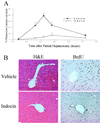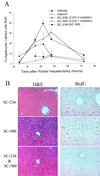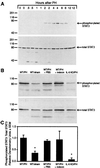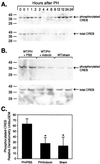Prostaglandins are required for CREB activation and cellular proliferation during liver regeneration
- PMID: 11447268
- PMCID: PMC37530
- DOI: 10.1073/pnas.151217998
Prostaglandins are required for CREB activation and cellular proliferation during liver regeneration
Abstract
The liver responds to multiple types of injury with an extraordinarily well orchestrated and tightly regulated form of regeneration. The response to partial hepatectomy has been used as a model system to elucidate the molecular basis of this regenerative response. In this study, we used cyclooxygenase (COX)-selective antagonists and -null mice to determine the role of prostaglandin signaling in the response of liver to partial hepatectomy. The results show that liver regeneration is markedly impaired when both COX-1 and COX-2 are inhibited by indocin or by a combination of the COX-1 selective antagonist, SC-560, and the COX-2 selective antagonist, SC-236. Inhibition of COX-2 alone partially inhibits regeneration whereas inhibition of COX-1 alone tends to delay regeneration. Neither the rise in IL-6 nor the activation of signal transducer and activator of transcription-3 (STAT3) that is seen during liver regeneration is inhibited by indocin or the selective COX antagonists. In contrast, indocin treatment prevents the activation of CREB by phosphorylation that occurs during hepatic regeneration. These data indicate that prostaglandin signaling is required during liver regeneration, that COX-2 plays a particularly important role but COX-1 is also involved, and implicate the activation of CREB rather than STAT3 as the mediator of prostaglandin signaling during liver regeneration.
Figures






References
-
- Michalopoulos G K, DeFrances M C. Science. 1997;276:60–66. - PubMed
-
- Diehl A M E, Rai R. In: Schiff's Diseases of the Liver. 8th Ed. Schiff R, Sorrell M C, Maddrey W C, editors. Philadelphia: Lippincott; 1999. pp. 39–54.
-
- Fausto N. J Hepatol. 2000;32,Supp. 1:19–31. - PubMed
-
- Higgins G M, Anderson R M. Arch Pathol. 1931;12:186–202.
-
- Boros P, Miller C M. Lancet. 1995;345:293–295. - PubMed
Publication types
MeSH terms
Substances
Grants and funding
LinkOut - more resources
Full Text Sources
Research Materials
Miscellaneous

